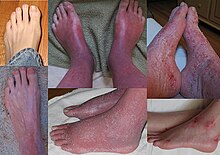Topical steroid withdrawal
Red burning skin, also known as topical steroid addiction and steroid dermatitis, has been reported in long-term users of topical steroids.[1][2] It generally requires the applying of a topical steroid at least daily for more than a year.[3] It has already been described in adults.[3]
Signs and symptoms


TSA is characterised by uncontrollable, spreading dermatitis and worsening skin inflammation which requires a stronger topical steroid to get the same result as the first prescription. When topical steroid medication is stopped, the skin experiences redness, burning, itching, hot skin, swelling, and/or oozing for a length of time. This is also called 'red skin syndrome' or 'topical steroid withdrawal' (TSW). After the withdrawal period is over the atopic dermatitis can cease or is less severe than it was before.[4]
Duration
The duration of acute topical corticosteroid withdrawal is variable, it can take months to years to return to the skin's original condition.[5] The duration of steroid use may influence the recovery factor time, with patient's who used steroids for the longest reporting the slowest recovery.
Mechanism of action
Historically, it was believed that cortisol was only produced by the adrenal glands. Recent research has shown that keratinocytes in human skin also produce cortisol.[6] It is believed that prolonged and continuous exposure to topical steroids interferes with the body's ability to regulate cortisol production.
History
This section needs expansion. You can help by adding to it. (July 2017) |
The first description of the condition occurred in 1979.[7]
References
- ^ Nnoruka, Edith; Daramola, Olaniyi; Ike, Samuel (2007). "Misuse and abuse of topical steroids: implications". Expert Review of Dermatology. 2 (1): 31–40. doi:10.1586/17469872.2.1.31. Retrieved 2014-12-18.
- ^ Sanjay, Rathi; D'Souza, Paschal (2012). "Rational and ethical use of topical corticosteroids based on safety and efficacy". Indian Journal of Dermatology. 57 (4): 251–259. doi:10.4103/0019-5154.97655.
{{cite journal}}: CS1 maint: unflagged free DOI (link) - ^ a b "Topical corticosteroid withdrawal". DermNet NZ. Retrieved 19 July 2016.
- ^ Fukaya, M; Sato, K; Sato, M; Kimata, H; Fujisawa, S; Dozono, H; Yoshizawa, J; Minaguchi, S (2014). "Topical steroid addiction in atopic dermatitis". Drug, healthcare and patient safety. 6: 131–8. doi:10.2147/dhps.s69201. PMC 4207549. PMID 25378953.
{{cite journal}}: CS1 maint: unflagged free DOI (link) - ^ Oakley, M.D., Amanda. "Topical corticosteroid withdrawal". DermNet NZ. DermNet New Zealand Trust.
- ^ Cirillo, N; Prime, S (2011). "Keratinocytes synthesize and activate cortisol". Journal of cellular biochemistry. 112: 1499–505. doi:10.1002/jcb.23081. PMID 21344493.
- ^ "Topical corticosteroid addiction and withdrawal – An overview for GPs". Jun 2016. Retrieved 23 July 2016.
{{cite journal}}: Cite journal requires|journal=(help)

